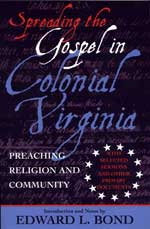

 |
Edward L. Bond, editor. Spreading the Gospel in Colonial Virginia: Sermons and Devotional Writings. Lanham, MD: Lexington Books in association with the Colonial Williamsburg Foundation, 2004. 571 pages. ISBN 0-7391-0720-8. Reviewed by Nicholas M. Beasley, for the Journal of Southern Religion.
| "Virginia's religious life here appears remarkably diverse and vibrant, at times contradictory, and certainly ambitious in its social goals." | |
In her foreword, historian Linda Rowe of the Colonial Williamsburg Foundation argues for the usefulness of a collection meant for “historians, professors, museum professionals, students, and readers of history” (xii). Certainly the book's appeal should be broad, especially for library collections. Harried faculty seeking to add weight to lectures on early Virginia or colonial religion will find here a convenient source for lecture illustrations. Imagine explaining Anglicanism's role in creating social power by quoting a minister's condemnation of “the pert reply, the Saucy Answer, the rude Contradiction, & other irreverent modes of Speech” (326). Advanced undergraduates and graduate students will treasure any volume that makes primary sources for the period so readily available. Thus the book is an essential addition to many collections, even if it is hard to imagine large numbers of readers tripping through the longest and driest of the sermons.
Specialists will appreciate the collection and Bond's introduction as further contributions to the historiographical debate over Virginia's religious life. Selecting documents from across the colonial period, Bond seeks to show “a Virginia more tolerant, more concerned about religion, and more religiously diverse than the traditional stereotype suggests” (2). Though Virginia dissenters complained of persecution and all Christian groups bemoaned inadequate resources for their ministries, Bond interprets these complaints as evidence of Virginians' deeply felt desire “for a religious presence in their lives” (3). Bond thus follows Joan Gundersen's The Anglican Ministry in Virginia, 1723-1766: A Study of a Social Class (1989) and John K. Nelson's A Blessed Company: Parishes, Parsons, and Parishioners in Anglican Virginia, 1690-1776 (2001) in arguing that most scholarship on religion in colonial Virginia has subconsciously reproduced period evangelical critiques of Anglicanism, failing to understand a liturgical religion rooted in the early modern English experience and overestimating clerical delinquency. Bond points to Rhys Isaac's Transformation of Virginia (1982) and Dell Upton's Holy Things and Profane: Anglican Parish Churches in Colonial Virginia (1986) as chief proponents of a “still reigning orthodoxy” that he seeks to undermine (n. 5, 47).
This debate may remind readers of a more confessional mode of religious history, one rooted in the religious landscape of early modern Europe, here as translated to Virginia. Indeed Bond's collection reveals a world where the debates of the Reformation were close at hand, as in James Blair's condemnation of “the Enthusiasts on the one Hand, and the Papists on the Other” (178). In general, the legacy of John Calvin swirls through these texts, often concerning modes of worship. Separate and Regular Baptists disagreed on balancing Calvinist orthodoxy and revivalistic practices, while Presbyterians condemned the Anglicans' liturgical observation of Christmas, with one following Calvin's hermeneutic in taking “my religion just as I find it in my Bible, without any imaginary improvements or supplements of human invention” (384). Certainly Anglicans gave as good as they got, condemning the “long extemporary Effusions” of the Puritans whose “long Prayers and other acted Devotions” provided cover as they “destroyed the King and Countrey by a Civil War…and glutted their Pride, Ambition, Covetousness, and Cruelty to the utmost” (211). Preaching about the recent past was clearly an important tool in the eighteenth century's religious debates.
Most of the material is prescriptive, articulated by clergy, and thus not a clear solution to the problem of religion in the pew. Many of the themes are hardly surprising, especially the heavy emphasis on submission to authorities. Even evangelicals allowed that Providence required that “some should rule, and some be subject; that some should be Masters, and some Servants” and that “Christianity does not blend or destroy these Distinctions, but establishes and regulates them” (426). But there are surprises as well, as in Anglican Robert Paxton's sermon that argued “(a)ll Men are equal in many things & those the greatest things” and that “in all those things wherein Men are Unequall the inequality is not fixed & constant, but mutable & by turns” and generally “not considerable” (150-1). Some readers will be surprised by Anglicans' frequent exhortations to private prayer and Bible reading. Sadly, the collection is not able to tell us much about practice, particularly the religious lives of those excluded from clerical power, especially women and Afro-Virginians.
Besides collecting material from several repositories, Bond has added notes, a general introduction, and introductions to each chapter of documents. The notes especially demonstrate considerable erudition, as Bond has run down a large number of biblical, classical, and patristic texts. An index would have made both the notes and texts themselves even more useful. The introduction is a helpful guide to religion in Virginia, dealing with the historiography and providing a brief narrative. Scholars of religion in early modern England may question Bond's understanding of the English background, especially when he speaks of “Anglicans and Puritans” and an “Anglo-Catholic” party in England in the 1630s (7). These slight anachronisms could have been eliminated through closer attention to the work of Patrick Collinson, Peter Lake, and Nicholas Tyacke, all of which points to a Calvinist consensus within the Church of England, over and against Peter White, whom Bond seems to endorse.
Such small complaints speak to the collection's great merits. It is bound to stimulate further work on the social, cultural, and religious history of colonial Virginia. Scholars should recognize Bond's work as a gift to all sorts and conditions of students, a gift that indeed deserves a place on many shelves.
Nicholas M. Beasley, Vanderbilt University
© 1998-2005 by The Journal of Southern Religion. All rights reserved. ISSN 1094-5253